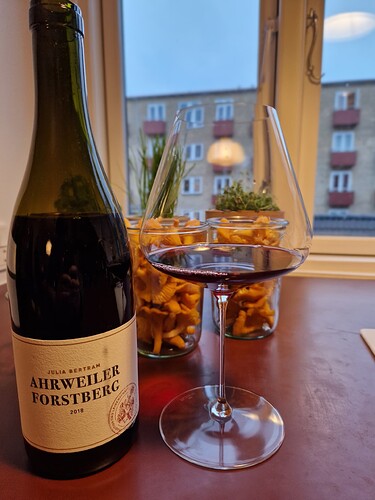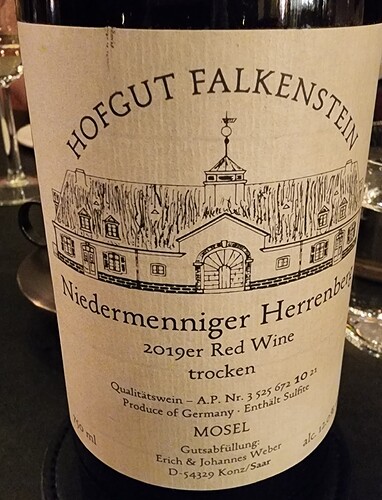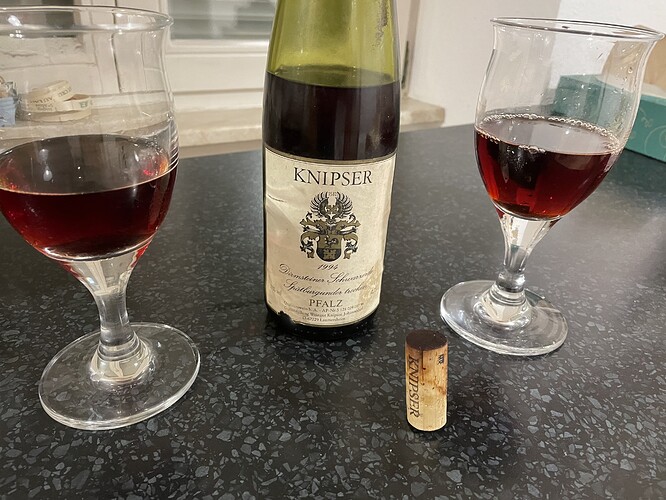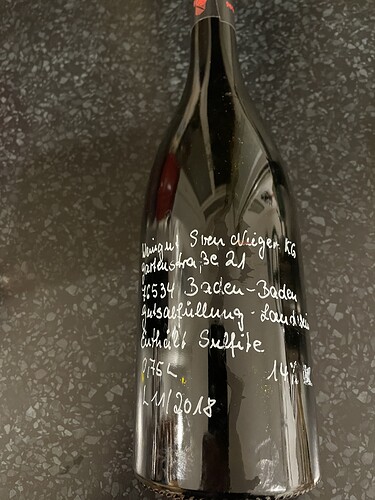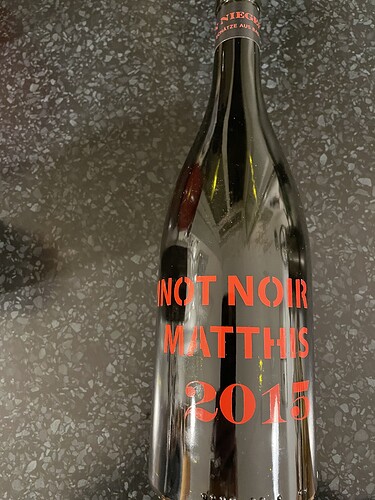Thanks for your tasting note. It’s a “red Riesling” from the Saar. I really like the 2021 vintage. We didn’t produce a red, only a rosé, in 2023.
That’s a great summary of the wine - Red Riesling.
Nonetheless in the name of science I would love to do the side by side ![]()
I think the Falkenstein reds can be deceptive. They can appear to be light and dare I say simple but then blossom into something really special with air or if you hit them at the right time. I have never kept one open for three days.
Thanks again. There is actually a white grape variety known as Roter Riesling. That’s why I put “Red Riesling” in quotation marks, because ours is made from Spätburgunder.
In one vintage, the red went through a partial malolactic conversion.
You surely might be right about that. What I can say though is that the wine was so closed down that I don’t think you would drink it through that fast to be honest.
It showed a bit more on the second night but was fully opened up by day 3.
And I had the Ziereisen bottle open at the same time which was open right away. Always have at least 2-3 bottles open at the same time when wanting to get to know a bottle or two more intimate with more time together ![]()
Thanks, Robert. The reds have never been our focus. But last year, David Schildknecht brought a 2011 Niedermenniger Sonnenberg Spätburgunder to Chicago that wowed folks and put some high-end red Burgundies to shame.
I know and don’t forget the Portland tasting! I know don’t miss much when it comes to Hofgut Falkenstein ![]()
Many of the top producers of German Spätburgunder try to emulate red Burgundy and even buy new or used 228-liter French oak barrels, whereas Erich and Johannes Weber of Hofgut Falkenstein age their reds in large oak casks.
I always liked the wines from Julia Bertram. This is very red fruited and elegant. The wines always have a very distinct herbal note. Not sure if it is the local oak that she used, but it is very distinctive and comes through in of all Julia’s wines. 12,5% abv.
Still have a few different 2018’s left. Pretty sure they will age very well. I have not tasted the Bertram-Baltes wines yet actually. But will certainly buy some as I really like this.
I’m glad you like it. As I mentioned before, there will be no red wine at Hofgut Falkenstein in the 2023 vintage, but the Webers have a rosé and will produce a rosé sparkling wine from Spätburgunder. (They also have a base wine for Riesling Sekt; the last vintage of Sekt made from their own base wine was in 2016.)
And now for something a bit different
Just a tad over the top, the color and the fruit started slowly fading away. Perfectly balanced, with good acidity and loooong finish. A highly satisfying glass of Pinot.
I just saw in Anne Krebiehl’s recent Vinous report on the Mosel that the VDP is now going to allow Pinot Noir to qualify for GG status in the Mosel.
I thought they weren’t able to use the “Spätburgunder” wording any more, as it was found out that it was in fact a different clone than initially thought to be? Maybe you can elaborate a bit on the story, Lars, if it’s not too much trouble? ![]()
Hi, Nikolaj. No problem. Beginning with the 2015 vintage, the Webers made a change to their label, because the authorities decided that a high level of shikimic acid in the 2015 reds meant that it couldn’t be Spätburgunder. The Webers didn’t want to dispute this and simply chose to label it as “red wine,” but they are certain that it’s not a mutation. This affected a number of grape growers who sold Spätburgunder to the co-op in 2015. In other words, it was a vintage phenomenon, and the Webers chose not to make it an issue. Back then, the Webers had several different parcels of Pinot Noir; now they have only two, one of which is a new planting.
FYI, Claude Kolm has been posting notes on 2018-2021 Spätburgunders on his blog recently:
To make my point more clearly, I should add that Hofgut Falkenstein had several parcels of Spätburgunder, each of which had different clones and different years of planting on various hillsides in Niedermennig. It’s highly unlikely that they all mutated into another variety.
As of today, the Webers have only two parcels of Spätburgunder, both in Niedermenniger Herrenberg. One is a new planting at the foot of the original slope, and the other, which has old vines, is at the top of the hill. (The latter was used to make the rosé for Soilpimp Selections.)
Thank you so much for taking the time, Lars - and for explaining it in so much detail.
That’s super interesting and I have yet to have the pleasure of trying one of the reds, but I will need to seek it out!
My pleasure, Nikolaj. Today is a holiday. I’m normally in the vineyard working during the day. That’s why my replies are often delayed. I really like the 2021 red from Hofgut Falkenstein.
This package in needy, wheezing in your face: I am cool, I am hip, I am natty, drink me and you will be cool too. So I was more than ready to bash this as a hipster folly.
But this is a splendid bottle of Pinot. Acidity and fruit in harmony, elegant tannins, long finish. With a little graphite kick, like licking a pencil.
